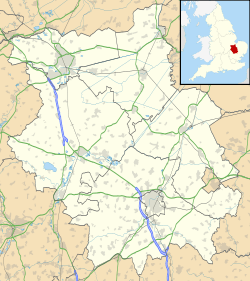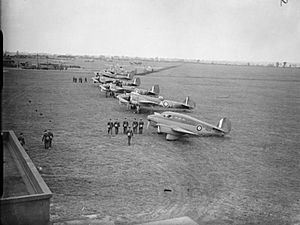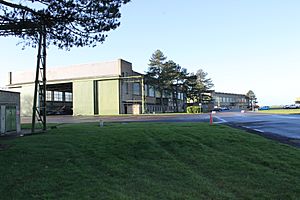RAF Wyton facts for kids
Quick facts for kids RAF Wyton
|
|||||||
|---|---|---|---|---|---|---|---|
| Near St Ives, Cambridgeshire in England | |||||||
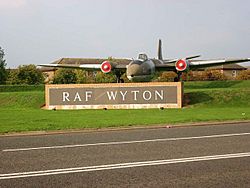
Canberra PR9 'XH170' which is RAF Wyton's gate guardian
|
|||||||
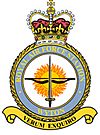
|
|||||||
|
Shown within Cambridgeshire
|
|||||||
| Coordinates | 52°21′26″N 000°06′28″W / 52.35722°N 0.10778°W | ||||||
| Type | Royal Air Force station | ||||||
| Site information | |||||||
| Owner | Ministry of Defence | ||||||
| Operator | Royal Air Force | ||||||
| Controlled by | Strategic Command | ||||||
| Condition | Operational | ||||||
| Site history | |||||||
| Built | 1915 | ||||||
| In use | 1916 – present | ||||||
| Garrison information | |||||||
| Current commander |
Wing Commander Keith Slack | ||||||
| Occupants |
|
||||||
| Airfield information | |||||||
| Identifiers | IATA: QUY, ICAO: EGUY, WMO: 03566 | ||||||
| Elevation | 40.2 metres (132 ft) AMSL | ||||||
|
|||||||
Royal Air Force Wyton, or simply RAF Wyton, is a special base for the Royal Air Force (RAF) located near St Ives in Cambridgeshire, England. Even though it used to be an airfield where planes took off and landed, it is now mainly used by the Joint Forces Intelligence Group. This group works on gathering and understanding important information for the UK's defence.
History of RAF Wyton
Early Years: A Flying Station
RAF Wyton has been a military airfield since 1916. It was first used for training pilots by the Royal Flying Corps. Later, it became a base for the new Royal Air Force (RAF).
Many different squadrons, which are groups of aircraft and their crews, were based at Wyton between 1916 and 1935. They helped train pilots and carry out various missions.
World War II: A Bomber Base
During the Second World War, RAF Wyton played a very important role. It was mainly used as a base for bomber planes. These planes included the Bristol Blenheim, de Havilland Mosquito, and Avro Lancaster.
In 1942, Wyton became the home of the Pathfinder Force. This was a special group of pilots and planes. They flew ahead of the main bomber force to mark targets for them. This made bombing missions much more accurate. Group Captain Don Bennett led this important force.
More squadrons were based at Wyton during the war, flying different types of aircraft to support the war effort.
Cold War Era: Reconnaissance and Training
After the Second World War, RAF Wyton continued to be an important base. It became home to English Electric Canberra planes. These aircraft were part of the Strategic Reconnaissance Force. Their job was to fly long distances and gather information.
Later, in 1955, Vickers Valiant planes arrived for No. 543 Squadron. In 1959, a Handley Page Victor plane joined for radar reconnaissance.
In 1974, three Nimrod R1s from No. 51 Squadron arrived. These planes were used for gathering electronic intelligence, like listening to enemy radio signals. In 1975, No. 360 Squadron also arrived. This was a joint RAF and Royal Navy squadron. They specialized in training for Electronic countermeasures, which means confusing enemy radar and communications.
Many different squadrons were based at Wyton between 1946 and 2011. They performed various roles, from reconnaissance to training.
21st Century Changes
In the early 1990s, a famous rugby player, Flight Lieutenant Rory Underwood, was one of the pilots based at RAF Wyton.
For a few months in 1989, two squadrons of U.S. Air Force Fairchild Republic A-10 Thunderbolt II jets operated from RAF Wyton. This happened while the runway at their usual base, nearby RAF Alconbury, was being repaired.
In May 1995, both RAF Wyton and RAF Alconbury airfields were officially closed for flying. Wyton then joined with RAF Brampton and later RAF Henlow. This meant all three locations were managed as one RAF station. Even though the airfield was decommissioned, light aircraft for the Cambridge and London University Air Squadrons continued to use it until 2015. They then moved to RAF Wittering.
RAF Wyton Today: Intelligence Hub
After a big review of defence plans in 2010, the combined RAF Brampton Wyton Henlow station was split up. RAF Henlow became a separate base again, and RAF Brampton was taken down.
Today, RAF Wyton is a key centre for intelligence. The Joint Forces Intelligence Group moved to RAF Wyton in 2013. This group is responsible for collecting and analyzing different types of intelligence. This includes signals intelligence (from communications), geospatial intelligence (from maps and locations), and imagery intelligence (from pictures).
In July 2014, 42 Engineer Regiment also moved to RAF Wyton. They work closely with the Joint Forces Intelligence Group, providing important mapping and geographic information. In April 2017, No. 1 Intelligence Surveillance Reconnaissance Squadron moved to Wyton from RAF Marham.
Units Based at RAF Wyton
RAF Wyton is home to several important units today.
Strategic Command
- Joint Forces Intelligence Group (JFIG): This group gathers and analyzes intelligence for the UK's defence.
- Defence Intelligence Fusion Centre (DIFC): A part of JFIG that combines different types of intelligence.
Defence Digital
- Defence Assurance and Information Security: This team helps keep important information safe and secure.
Royal Air Force
No. 1 Group (Air Combat) RAF
- No. 1 Intelligence Surveillance Reconnaissance Wing: This wing focuses on gathering intelligence.
- No. 1 Intelligence Surveillance Reconnaissance Squadron
- RAF Wyton Area Voluntary Band: A band made up of volunteers from the RAF Wyton area.
No. 22 Group (Training) RAF
- Headquarters, Central & Eastern Region, Air Training Corps
- Headquarters, Bedfordshire and Cambridgeshire Wing, Air Training Corps
- No. 2331 (St Ives) Squadron (Air Training Corps): These are cadet units for young people interested in aviation and the RAF.
British Army
Royal Engineers
- 42 Engineer Regiment (Geographic): This regiment provides important geographic information and maps.
- 13 Geographic Squadron
- 14 Geographic Squadron
- 16 Geographic Support Squadron
- 135 Geographic Squadron
Ministry of Defence
- Defence Infrastructure Organisation: This group manages the buildings and land used by the Ministry of Defence.
- Defence Intelligence Estates Rationalisation Team (PRIDE)
- Ministry of Defence Police: These police officers provide security for Ministry of Defence sites.
United States Department of Defense
- Defense Contract Management Agency – United Kingdom: This agency helps manage contracts for the US Department of Defense in the UK.
See also
- List of Royal Air Force stations
- RAF Wyton Area Voluntary Band


